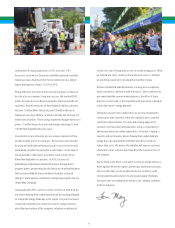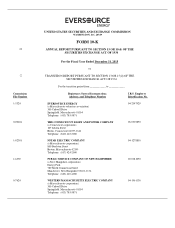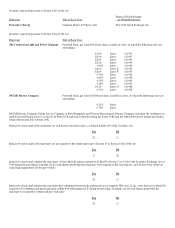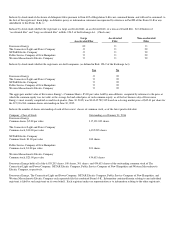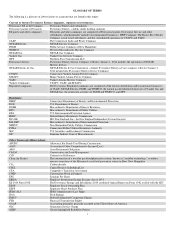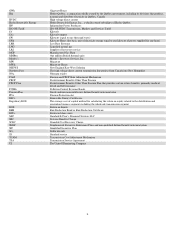Eversource 2015 Annual Report Download - page 16
Download and view the complete annual report
Please find page 16 of the 2015 Eversource annual report below. You can navigate through the pages in the report by either clicking on the pages listed below, or by using the keyword search tool below to find specific information within the annual report.4
The rates established by the PURA for CL&P are comprised of the following:
• An electric generation services charge (GSC), which recovers energy-related costs incurred as a result of providing electric generation
service supply to all customers that have not migrated to competitive energy suppliers. The GSC is adjusted periodically and reconciled
semi-annually in accordance with the policies and procedures of the PURA, with any differences refunded to, or recovered from,
customers.
• A revenue decoupling adjustment (effective December 1, 2014) that reconciles the amounts recovered from customers, on an annual basis,
to the distribution revenue requirement approved by the PURA in its last rate case, which currently is an annual amount of $1.059 billion.
• A distribution charge, which includes a fixed customer charge and a demand and/or energy charge to collect the costs of building and
expanding the infrastructure to deliver power to customers, as well as ongoing operating costs to maintain the infrastructure.
• A federally-mandated congestion charge (FMCC), which recovers any costs imposed by the FERC as part of the New England Standard
Market Design, including locational marginal pricing, locational installed capacity payments, and any costs approved by the PURA to
reduce these charges. The FMCC also recovers costs associated with CL&P’s system resiliency program. The FMCC is adjusted
periodically and reconciled semi-annually in accordance with the policies and procedures of the PURA, with any differences refunded to,
or recovered from, customers.
• A transmission charge that recovers the cost of transporting electricity over high voltage lines from generating plants to substations,
including costs allocated by ISO-NE to maintain the wholesale electric market.
• A competitive transition assessment charge (CTA), assessed to recover stranded costs associated with electric industry restructuring such as
various IPP contracts. The CTA is reconciled annually to actual costs incurred and reviewed by the PURA, with any difference refunded
to, or recovered from, customers.
• A systems benefits charge (SBC), established to fund expenses associated with: various hardship and low income programs; a program to
compensate municipalities for losses in property tax revenue due to decreases in the value of electric generating facilities resulting directly
from electric industry restructuring. The SBC is reconciled annually to actual costs incurred and reviewed by the PURA, with any
difference refunded to, or recovered from, customers.
• A Clean Energy Fund charge, which is used to promote investment in renewable energy sources. Amounts collected by this charge are
deposited into the Clean Energy Fund and administered by the Clean Energy Finance and Investment Authority. The Clean Energy Fund
charge is set by statute and is currently 0.1 cent per kWh.
• A conservation charge, comprised of a statutory rate established to implement cost-effective energy conservation programs and market
transformation initiatives, plus a conservation adjustment mechanism charge to recover the residual energy efficiency spending associated
with the expanded energy efficiency costs directed by the Comprehensive Energy Strategy Plan for Connecticut.
As required by regulation, CL&P, jointly with UI, entered into the following contracts whereby UI will share 20 percent and CL&P will share 80
percent of the costs and benefits (CL&P’s portion of these costs are either recovered from, or refunded to, customers through the FMCC charge):
• Four CfDs (totaling approximately 787 MW of capacity) with three electric generation units and one demand response project, which
extend through 2026 and have terms of up to 15 years beginning in 2009. The capacity CfDs obligate both CL&P and UI to make or
receive payments on a monthly basis to or from the project and generation owners based on the difference between a contractually set
capacity price and the capacity market prices that the project and generation owners receive in the ISO-NE capacity markets.
• Three CfDs (totaling approximately 500 MW of peaking capacity) with three peaking generation units. The three peaker CfDs pay the
generation owners the difference between capacity, forward reserve and energy market revenues and a cost-of service payment stream for
30 years beginning in 2008 (including costs of plant operation and the prices that the generation owners receive for capacity and other
products in the ISO-NE markets).
• Long-term commitments to purchase approximately 250 MW of wind power from a Maine wind farm and 20 MW of solar power from a
multi-site project in Connecticut. Both of these projects are expected to be operational by the end of 2016.
On December 17, 2014 the PURA approved CL&P’s application to amend customer rates, effective December 1, 2014, for a total base distribution
rate increase of $152 million, which includes an authorized ROE of 9.02 percent for the first twelve month period and 9.17 percent thereafter. The
distribution rate increase included a revenue decoupling mechanism effective December 1, 2014, and the recovery of 2011 and 2012 storm
restoration costs and system resiliency costs. Also in December 2014, the PURA granted a re-opener request to CL&P’s base distribution rate
application for further review of the appropriate balance of ADIT utilized in the calculation of rate base. On July 2, 2015, the PURA issued a final
order that approved a settlement agreement filed on May 19, 2015 between CL&P and the PURA Prosecutorial Staff, and which included an increase
to total allowed annual revenue requirements of $18.4 million beginning December 1, 2014.


